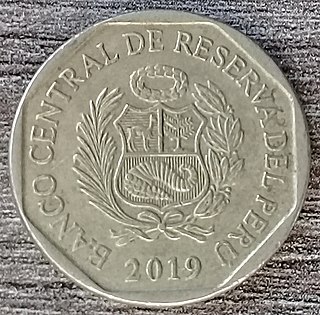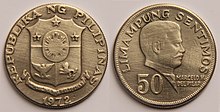
Centime is French for "cent", and is used in English as the name of the fraction currency in several Francophone countries.

The peseta was the currency of Spain between 1868 and 2002. Along with the French franc, it was also a de facto currency used in Andorra.
Decimalisation or decimalization is the conversion of a system of currency or of weights and measures to units related by powers of 10.

The Philippine peso, also referred to by its Filipino name piso, is the official currency of the Philippines. It is subdivided into 100 sentimo, also called centavos.

The cent is a monetary unit of many national currencies that equals 1⁄100 of the basic monetary unit.

The Portuguese escudo was the currency of Portugal from 22 May 1911 until the introduction of the euro on 1 January 2002. The escudo was subdivided into 100 centavos. The word escudo derives from the scutum shield.
The centavo is a fractional monetary unit that represents one hundredth of a basic monetary unit in many countries around the world. The term comes from Latin centum, with the added suffix -avo ('portion').
Several linguistic issues have arisen in relation to the spelling of the words euro and cent in the many languages of the member states of the European Union, as well as in relation to grammar and the formation of plurals.
Each "article" in this category is a collection of entries about several stamp issuers, presented in alphabetical order. The entries are formulated on the micro model and so provide summary information about all known issuers.
Each "article" in this category is a collection of entries about several stamp issuers, presented in alphabetical order. The entries are formulated on the micro model and so provide summary information about all known issuers.
Each "article" in this category is a collection of entries about several stamp issuers, presented in alphabetical order. The entries are formulated on the micro model and so provide summary information about all known issuers.

Each "article" in this category is a collection of entries about several stamp issuers, presented in alphabetical order. The entries are formulated on the micro model and so provide summary information about all known issuers.
Each "article" in this category is a collection of entries about several stamp issuers, presented in alphabetical order. The entries are formulated on the micro model and so provide summary information about all known issuers.
Each "article" in this category is a collection of entries about several stamp issuers, presented in alphabetical order. The entries are formulated on the micro model and so provide summary information about all known issuers.
Each "article" in this category is a collection of entries about several stamp issuers, presented in alphabetical order. The entries are formulated on the micro model and so provide summary information about all known issuers.
Each "article" in this category is a collection of entries about several stamp issuers, presented in alphabetical order. The entries are formulated on the micro model and so provide summary information about all known issuers.

The real was a unit of currency in Spain for several centuries after the mid-14th century. It underwent several changes in value relative to other units throughout its lifetime until it was replaced by the peseta in 1868. The most common denomination for the currency was the silver eight-realSpanish dollar or peso which was used throughout Europe, America and Asia during the height of the Spanish Empire.

The sol is the currency of Peru; it is subdivided into 100 céntimos ("cents"). The ISO 4217 currency code is PEN.
The Sahrawi peseta is the de jure currency of the partially recognized Sahrawi Arab Democratic Republic. It is divided in 100 céntimos, although coins with this denomination have never been minted, nor have banknotes been printed.

The one-sentimo coin (1¢) is the smallest-denomination coin of the Philippine peso. It has been issued since 1903 during American rule. It became the smallest unit of currency following the removal of the half-centavo in 1908.









